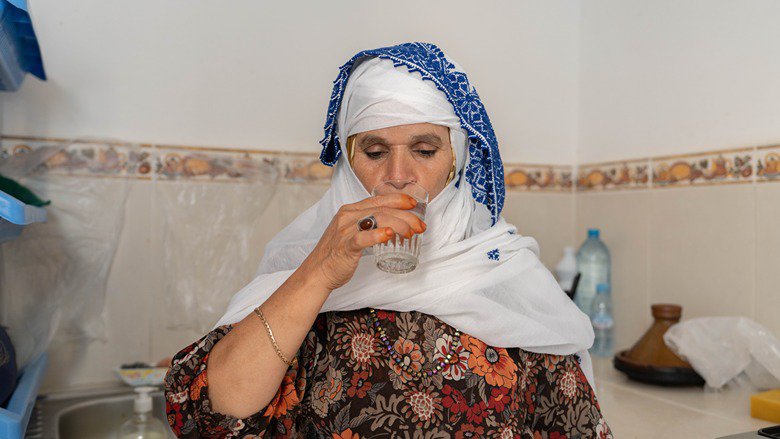LAAOUISSATE, Morocco - Before a standpipe was installed to bring clean drinking water to her village, Saadia El Haddouri’s seven children usually drank the untreated water used to irrigate crops. She knew it was not healthy and one of her sons got so sick one year from the contaminated water that he had to go to the hospital.
But the family had little choice. The alternative was to walk 10 kms to fetch clean water, which took up much of the day and often kept children out of school. Then a water pipe was laid all the way to the village to bring water from a potable water treatment plant and residents could collect it from a centrally located standpipe, fitted with a faucet.
“Before, we struggled to get access to clean water,” says El Haddouri. “Girls and women used to go far to bring it. Now, thank God, the [clean] water is close to us and girls can go to school.”
El Haddouri’s village of Laaouissate, in the El Jadida area on Morocco’s Atlantic coast, is one of more than 2,000 douars (as Moroccan villages are called) to have been connected to a reliable supply of potable water since 2014 under the World Bank-funded “Rural Water Supply Project”.
SUPPORTING MOROCCO’S EFFORTS TO EXTEND ITS TREATED WATER SUPPLY
Morocco’s government launched an ambitious program in 1995, known as “PAGER” (Programme d’Approvisionnement Groupé en Eau Potable des Populations Rurales) to get potable water to rural villages. At that time, only around 14 percent of Morocco’s rural population had regular access to safe drinking water. The remaining population had to walk great distances to fetch water, purchase unregulated and expensive water from tanker trucks, or drink unsafe water from streams, agricultural canals, or wells.
The World Bank has supported the PAGER program through a series of projects since 2005. A big contribution has been helping to connect rural areas to major water pipelines that carry treated water sourced from dams and ground water resources. This approach has helped to build resilience in drought-prone Morocco while offering rural dwellers a continuous supply of treated water instead of the unsafe water that previously came from wells and streams.
The most recent phase of the Rural Water Supply Project, financed by the World Bank since 2014, included investment and technical support amounting to about US$160 million. The project targeted douars in the most remote areas, especially along the Atlantic coast and in the Rif and Pré-Rif regions. When the project closed in March 2023, close to 1.1 million people had gained access to a potable water supply, either through standpipes or individual household connections.
In addition to providing access to water, the project contributed to two major objectives of the national program – getting water to remote areas in a sustainable way and providing household connections to more densely populated areas.
The project reached more remote communities by providing centrally located standpipes in villages. To deliver a quality service and hence make it sustainable, a caretaker is chosen by the local community, ensuring any minor leaks are quickly fixed and the standpipe is well maintained. ONEE (the National Office for Electricity and Water) collects a standard fee of 2.54 DH (approximately USD 0.25) per m3 for the water it sells to the caretaker, who in turn sells the water to residents for a maximum fee of 10 DH (approximately USD 1) per m3. This allows the caretaker to make a small profit and incentivizes the continuous operation and maintenance of the standpipe.
GETTING COMMUNITY BUY-IN AND PROVIDING JOBS
Rachid El Kamouni, ONEE director for Sidi Bennour province, says the project’s main objective has been “to improve the quality of life of the population,” but he adds that it also created jobs for more than 2,000 local standpipe caretakers.
Organizers say the system is working well. Laarbi Idahraoui, who wears a frayed, broad-brimmed straw hat to protect his furrowed face from the sun, is the standpipe caretaker in El Haddouri’s village of Laaouissate. “In the past, we struggled for water,” he recalls. “Now we have access to this public fountain. The water is 100 percent pure and everyone is benefiting.”
For the second objective to be met – providing household connections in more densely populated areas – additional sanitation is required to handle wastewater from household faucets. Community buy-in is essential and village meetings are organized to inform residents about the benefits and costs of this option and to determine if a majority of residents want it. The douar must then come up with a plan for a sewer system. To ease the burden of a set-up charge for the sewer system, a revolving fund was created which allows homes to stagger payments for a connection fee rather than pay all at once.
“The benefits of bringing clean drinking water to Morocco’s most remote areas are clear—it reduces the burden of disease from unclean water and saves residents time wasted fetching water from distant locations,” said Carolina Dominguez-Torres, a Senior Water and Sanitation Specialist at the World Bank, who was also the project leader for the past four years. “As a result, more young people are able to attend school and adults can devote themselves to more productive activities.”
With the World Bank project concluded, Morocco is continuing its own efforts to connect the last of its residents who do not have access to clean drinking water.
